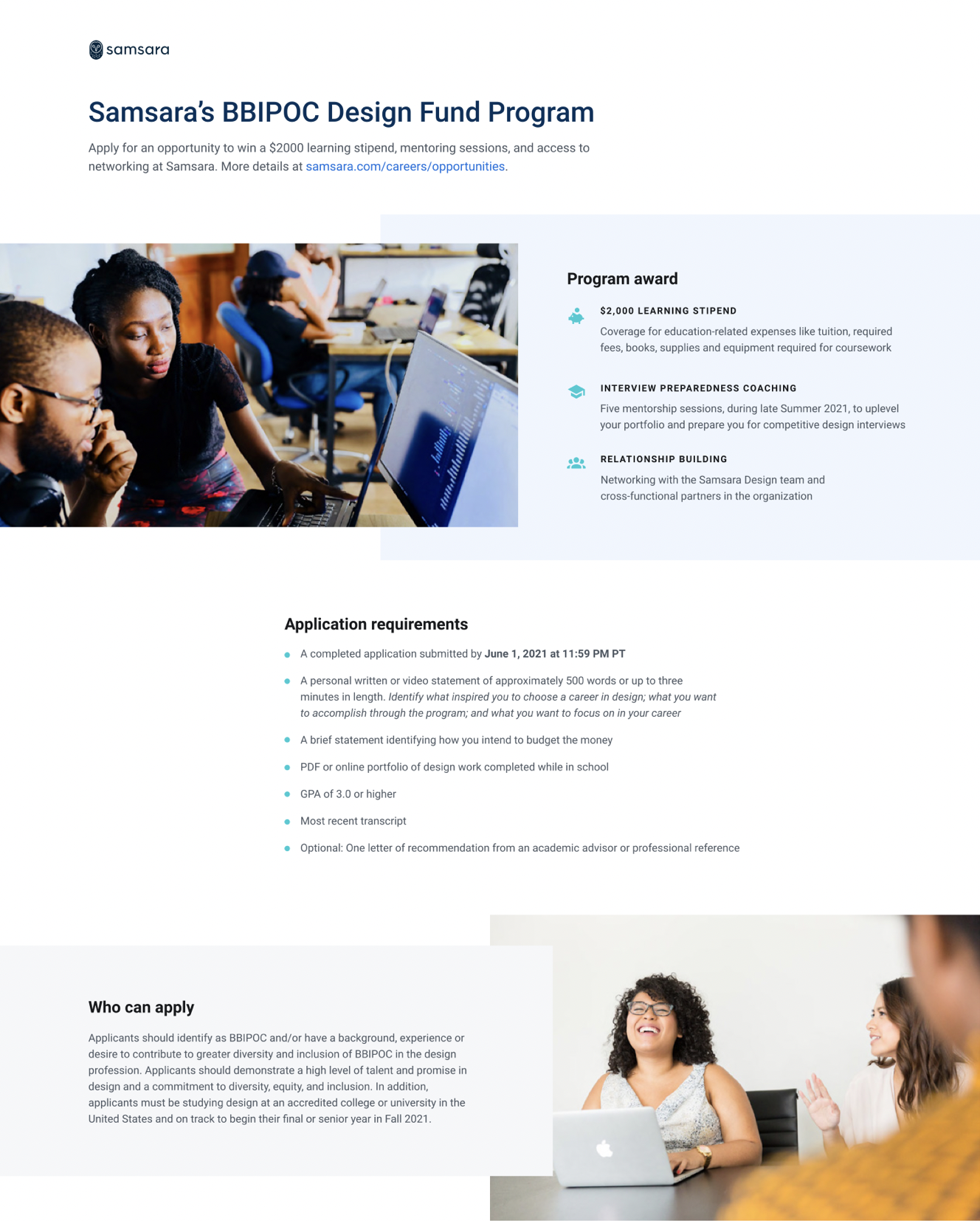Designing Access: A Mentorship Program Rooted in Growth
I founded and led the BBIPOC Design Fund, a first-of-its-kind mentorship program at Samsara built to expand access to product design opportunities in tech. Working with the support of ERG co-leads and stakeholders across Marketing, Legal, People Ops, Product Design, PR, and the DEI Steering Committee, I developed and pitched the program, secured executive buy-in, and guided its implementation. The initiative provided mentees with career resources, a learning stipend, one-on-one coaching from senior design ICs, and AMAs with design leadership — creating growth opportunities for both mentors and mentees.
BACKGROUND
Design for Social Systems is about creating change by redesigning how people and structures interact — not just building products, but shaping the conditions that make growth possible. At Samsara, I applied this approach to close a mentorship gap within the design organization. The result was a scalable model that connected senior designers with emerging talent outside the company — strengthening the team’s culture, confidence, and recruiting pipeline in the process.
OBJECTIVE
Design a sustainable mentorship model that strengthened Samsara’s design culture and pipeline while helping emerging designers build real-world confidence, connections, and career readiness.
PROBLEM
Samsara’s design team had few opportunities for structured mentorship, and early-career designers lacked access to credible guidance from working professionals. Without a system for connection, valuable experience and talent on both sides went untapped.
HYPOTHESIS
A structured mentorship model pairing Samsara’s senior ICs with emerging designers — supported by funding, leadership visibility, and practical learning tools — would strengthen the design team’s culture while expanding access to product design careers.
USERS
Emerging Designers: Students seeking mentorship, portfolio feedback, and guidance entering the industry.
Samsara Mentors: Senior ICs looking for career-building mentorship experience and leadership growth.
Stakeholders: ERG co-leads and XFN partners invested in talent, recruiting, and community impact.
APPROACH
Built alignment with ERG co-leads, Marketing, Legal, People Ops, Product Design, and PR.
Defined goals and success metrics: participant satisfaction (CSAT 85+), senior IC engagement (90%), and mentee recruitment targets.
Designed a five-week program with 1:1 mentorship, AMAs with design leadership, and shared resources for portfolio and interview prep.
Managed manual outreach, database creation, and applicant tracking for the pilot cohort.
Facilitated post-program surveys and retros to measure impact and gather feedback from mentors and mentees.
SOLUTIONS
Launched the BBIPOC Design Fund, awarding $2,000 stipends to selected design students for mentorship participation.
Created a shared resource library with templates, career tips, and interview guides.
Facilitated 1:1 mentorships and group AMAs connecting mentees with senior ICs and design leadership.
Developed an operational framework for future cohorts with DEI and People Ops support.
RESULTS
CSAT: 87% satisfaction across mentees, mentors, and collaborators.
Participation: 92% engagement among senior ICs.
Recruiting impact: Established relationships with new universities and diverse talent pools.
Cultural impact: Increased team visibility, confidence, and mentorship fluency across design.
LEARNINGS
Small, well-scoped pilots can drive large cultural outcomes when paired with cross-functional support.
Mentorship built confidence not just for students, but for senior ICs developing leadership skills.
Manual operations created clarity for future automation and scale.
Meaningful access work happens when design is used to redesign systems — not just products.
Credits: Website, image sourcing, and collateral design by Jenn Nyugen
Credits: (Clockwise L to R) Virtual design challenge by Jenn Nyugen; Mentorship guide by Hendrika Makilya; Portfolio presentation guide: Hendrika Makilya and Jenn Nyugen

